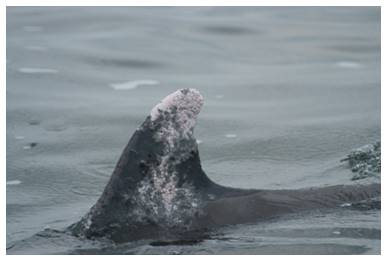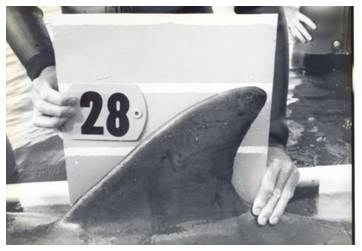Second-oldest male dolphin in Sarasota Bay dies
Photo: FB28 in 1976. Photo by Sarasota Dolphin Research Program, taken under National Marine Fisheries Service Scientific Research Permit No. 15543.
The second-oldest male resident dolphin of Sarasota Bay was recovered dead by Mote Marine Laboratory’s Stranding Investigations Program on the evening of Oct. 17 near the southern end of Longboat Key. The dolphin’s carcass, decomposed and scavenged by sharks, was identified as FB28 — an individual known to the Sarasota Dolphin Research Program (SDRP) for more than four decades.
FB28 was 50 years old. He was first identified in March 1971, during a pilot dolphin tagging study based at Mote. Since then, he was observed more than 500 times by SDRP, which is a program of the Chicago Zoological Society in partnership with Mote Marine Laboratory.
“It’s very sad when one of our long-term resident dolphins dies, but we value the opportunity to know what happened to him at the end,” said Randall Wells, Director of SDRP.
“We will be conducting a necropsy this week to learn as much as we can, adding to the detailed record of this animal’s long life, which has already served as an important resource for dolphin researchers,” said Gretchen Lovewell, manager of Mote’s Stranding Investigations Program. After the necropsy (animal autopsy), FB28’s skeleton will be archived for future research in the Ruth DeLynn Cetacean Osteological Collection at Mote.
FB28 ranged from southern Tampa Bay through Sarasota Bay, but spent most of his time in the northern portion of this range. He was seen with more than 300 different dolphins over the years. He had close pair bonds with other males – a common pattern for bottlenose dolphins in Sarasota Bay and elsewhere – but he outlived each of them. In recent years, he was seen occasionally with the oldest male resident, F154, also known from the pilot tagging study.
FB28 sired at least two calves, and probably a third, all with the female dolphin known to researchers as Pecan Sandie, a seasonal visitor from Tampa Bay. Although their mother disappeared five years ago, all three calves continue to be seen during SDRP monitoring surveys.
In the latter decades of his life, FB28 contracted a fungal disease known as Lacaziosis (previously called Lobomycosis). The coverage of much of his dorsal fin by this white, crusty, cauliflower-like skin disease made FB28 one of the most recognizable dolphins in the region. This disease was first described for bottlenose dolphins from a Sarasota Bay dolphin recovered and necropsied in 1970 by Blair Irvine and Wells at Mote. Previously, it was only known from humans in Central and South America. Subsequently, this disease has been observed on cetaceans around the world. Doctoral student Leslie Hart from the Medical University of South Carolina based a portion of her dissertation on tracking the development of this disease on FB28 over time. Animals afflicted with this skin disease can survive many years without obvious ill effects.
In his later years, FB28 began to interact with humans to a greater extent, patrolling around anglers in boats and on fishing piers and scavenging on discarded bait and catch. In 2007 he became entangled in monofilament fishing line, with multiple strands stretched taut between his dorsal fin and his tail fluke. A rescue team from SDRP was able to cut the line, and the remaining strands came off on their own.
Wells said: “FB28 was an important contributor to our understanding of coastal bottlenose dolphins’ lives, as he was one of the first dolphins to show us that these animals are resident to specific ranges they maintain over decades. We want to share his story to remind people of the challenges these animals face in the course of their everyday lives, both from human and natural sources.”

Photo: FB28 in 2007, with monofilament fishing line stretched taut between his dorsal fin and fluke. The white crusty skin disease evident on his dorsal fin is a fungal disease, Lacaziosis. Photo by Sarasota Dolphin Research Program, taken under National Marine Fisheries Service Scientific Research Permit No. 15543.
